[Michael visits a show that takes on the age-old artistic challenge of portraiture in inexpensive and unusual media. — the Artblog editors]
Main Line Art Center’s Face Value focuses on portraits composed with alternative materials, such as masking tape, mirrors, and latex. The show resembles a contemporary take on Arte Povera–a 1960s-era Italian art movement characterized by work fashioned with “poor” materials (nontraditional, everyday items) and made in unconventional ways.
Featuring the work of three Philadelphia artists–Steven Earl Weber, Nick Cassway, and Mark Khaisman–the exhibition challenges conventional notions of art and beauty in portraiture. Cassway, Khaisman, and Weber maintain the expressive and compositional elements traditionally found in portraiture, but turn the practice on its head with atypical media to produce exciting results.
Facing social issues
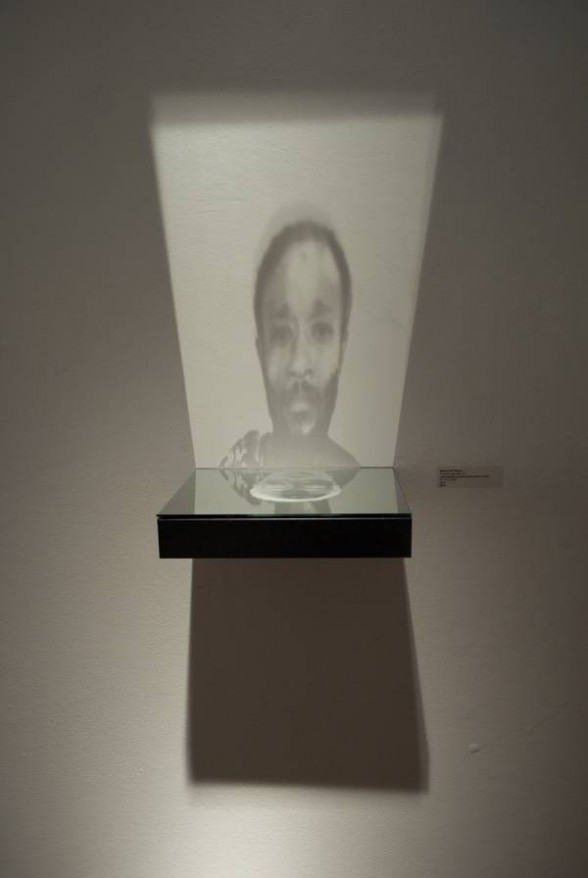
Weber takes iPhone photographs of drug-addicted Philadelphians, then screenprints the images on sheets of glass and mirrors and paints on top of them, resulting in muddied, mixed-media portraits that, to some extent, resemble old daguerreotypes. Weber alters the viewing experience of his artwork by presenting the viewer with reflections and shadows of his subjects, which, when paired with their quoted titles, like “I need to get well,” skew the observer’s perception of each subject. The artist’s decision forces the viewer to address social issues, such as drug addiction and homelessness, that society at large often shies away from.
Some individuals are featured multiple times, with slight variations in each print; I found this perplexing, as the fractured imagery defies one concrete narrative, almost suggesting that there is not one single story that Weber intends to tell.
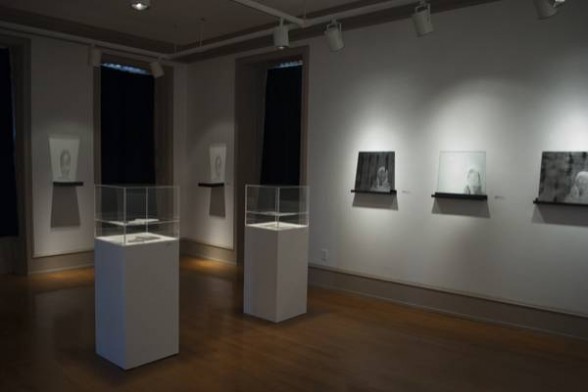
In his artist’s statement, Weber says that his subjects are “those that one routinely sees but tries not to notice.” Any city-dweller can think of a situation where you’re walking down the street and encounter someone who asks for change or a bite to eat. Because of the universality of this experience, Weber suggests that it is time to stand up and change our perceptions of people in need. The artist does not suggest a solution for what can be done to aid people who live on the street or who are unable to support themselves; instead, he asks audiences to acknowledge the existence of individuals on the street. Perhaps he is hoping to create a snowball effect that will eventually remedy class issues in society.
Confederate connections
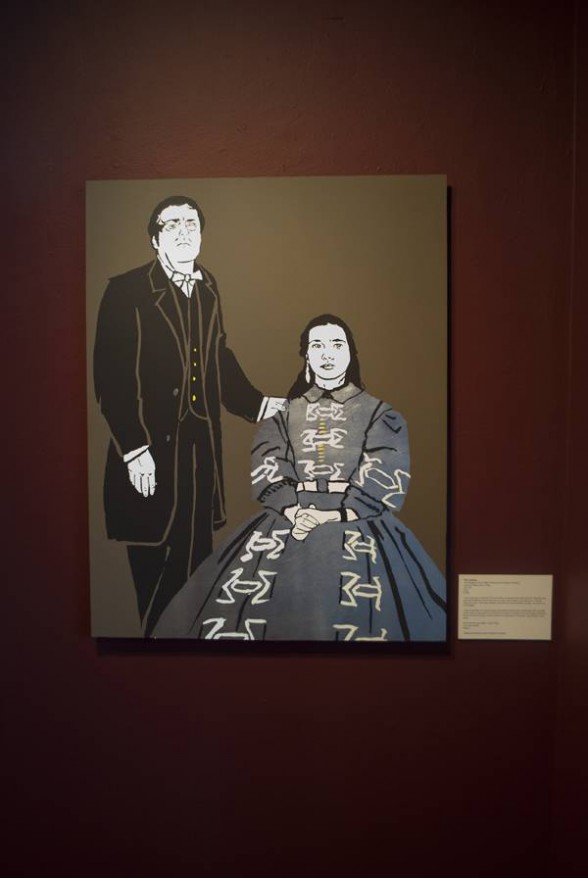
In a quasi-historically accurate pictorial narrative, Nick Cassway recounts the life of Philadelphia native and Confederate general John C. Pemberton with a series of cut-vinyl family portraits and battle scenes. He uses cut vinyl, a process commonly reserved for sign-making, as a means of processing his artwork in both analog and digital formats to create flat, graphic portraits.
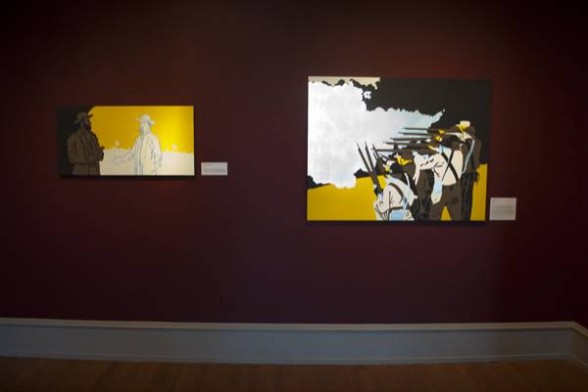
The Pemberton series is richly adorned with bands of metallic leaf, juxtaposed with the deep red, blue, and yellow hues of the cut vinyl. Although the work is highly graphic, it holds an elevated level of prestige with its velvety hues and ornate metallic accoutrements, which one might expect from a refined oil painting.
The shapes of each cut vinyl scene are generalized, yet they illustrate events of Pemberton’s life: a story filled with love, loss, war, and surrender. Cassway’s bold, flat colors, paired with his minimal, gestural strokes, contribute to illustrating the straightforward nature of Pemberton’s life. This allows ample time for the viewer to relate to universal themes, like triumph and defeat, in the general’s life.
Cassway’s highly graphic style also makes this material about an obscure Confederate general accessible to today’s audience. The artist explains that General Pemberton’s tarnished reputation after surrendering at Vicksburg prevented him from being buried in the South. Pemberton fought to maintain a decent legacy for many years after his surrender, but later passed away and was buried at Laurel Hill Cemetery in Philadelphia.
At first, this seems an odd choice of subject matter for Cassway, but the archetypal nature of the general’s rise and fall is highly relatable–not to mention that Pemberton was born and buried in Philadelphia, the artist’s native city.
Graphic design-inspired portraits
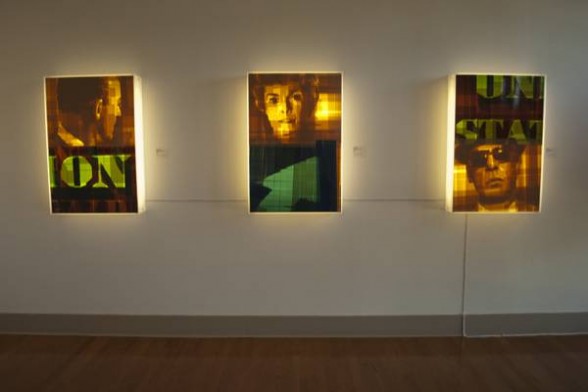
Mark Khaisman’s translucent packaging tape portraits are the most intricate and strikingly minimal artworks in Face Value. The most stimulating aspect of the artist’s work is his use of light. He constructs backlit light boxes to irradiate his tape designs, but he also utilizes natural light by adhering a series of red tape portraits to windows as a low-fi alternative to stained glass (a medium in which Khaisman is well-versed).
Not only is Khaisman capable of laying out a beautiful portrait, he is able to illuminate his portraits so that they appear as abstracted forms in chiaroscuro. His eye for detail and ability to elucidate a mythology derived from Western culture–specifically Hollywood and film culture–is unique and exciting. He uses modern media culture as a basis for his Western mythology, but it is unclear to what end he hopes the imagery will guide the viewer.
The only off note surfaces in Khaisman’s Tape Noir series, with imagery taken from iconic film noir video stills. In this series, Khaisman includes pockets of colorful tape; these interject an unnecessary element that overwhelms and carves into the otherwise subtle portraits.
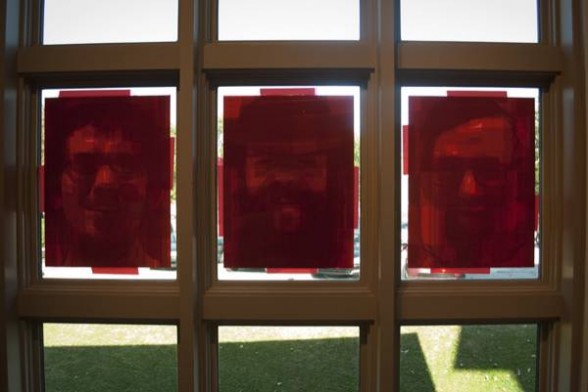
All in all, Face Value is a stimulating example of the diverse number of portrait styles that exist in today’s art world. At a time when selfies rule the Internet, and most artists shy away from direct portraiture, Weber, Cassway, and Khaisman go beyond experimentation and deliver a path forward for the portrait. Following in the footsteps of Andy Warhol, they are using graphic design techniques to reassert the human face in art in a flashy, captivating way.
Face Value is on display at the Main Line Art Center from Oct. 6 – Nov. 5, 2014, at 746 Panmure Road, Haverford, PA.









